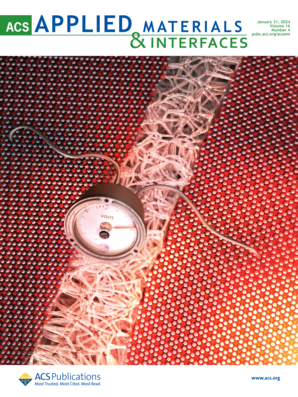Gradient Lamellar SiC Nanowire Networks with Dense Coating for High-Performance Reusable Thermal Protection Materials
IF 8.3
2区 材料科学
Q1 MATERIALS SCIENCE, MULTIDISCIPLINARY
引用次数: 0
Abstract
As space exploration advances, reusable thermal protection materials are essential for spacecraft that must withstand extreme aerodynamic heating during reentry. SiC nanowire aerogels offer a combination of ultralow density, excellent thermal insulation, and inherent oxidation resistance, but their application is limited by insufficient thermal stability above 1200 °C in oxygen-rich environments. In this study, a layered SiC nanowire network was fabricated by hot-pressing to enhance nanowire cross-linking and reduce pore size. A dense SiC coating was subsequently introduced via chemical vapor infiltration (CVI), forming a gradient structure with nanowire diameters decreasing from surface to core. This design yields a low density of 640 mg·cm–3, high compressive strength of 10.1 MPa, and exceptional ablation resistance. During 60 s of oxyacetylene torch ablation at 1800 °C, the material exhibited a negative mass ablation rate of −0.02 mg·s–1 and a negative linear ablation rate of −1.05 μm·s–1. These results demonstrate a promising structural strategy for enhancing the mechanical and thermal robustness of ceramic aerogels, advancing their application in extremely high-temperature environments.

具有致密涂层的梯度层状SiC纳米线网络用于高性能可重复使用的热防护材料
随着太空探索的推进,可重复使用的热保护材料对于必须承受重返大气层期间极端气动加热的航天器来说至关重要。碳化硅纳米线气凝胶集超低密度、优异的隔热性能和固有的抗氧化性于一身,但由于在富氧环境中温度超过 1200 ℃ 时热稳定性不足,其应用受到限制。在本研究中,通过热压法制造了层状碳化硅纳米线网络,以增强纳米线交联并减小孔径。随后,通过化学气相渗透(CVI)引入致密的碳化硅涂层,形成纳米线直径由表及里逐渐减小的梯度结构。这种设计产生了 640 mg-cm-3 的低密度、10.1 MPa 的高抗压强度和优异的耐烧蚀性。在 1800 °C 氧乙炔炬烧蚀 60 秒期间,该材料的负质量烧蚀率为-0.02 mg-s-1,负线性烧蚀率为-1.05 μm-s-1。这些结果表明了一种很有前景的结构策略,可增强陶瓷气凝胶的机械和热稳定性,从而推动其在极高温环境中的应用。
本文章由计算机程序翻译,如有差异,请以英文原文为准。
求助全文
约1分钟内获得全文
求助全文
来源期刊

ACS Applied Materials & Interfaces
工程技术-材料科学:综合
CiteScore
16.00
自引率
6.30%
发文量
4978
审稿时长
1.8 months
期刊介绍:
ACS Applied Materials & Interfaces is a leading interdisciplinary journal that brings together chemists, engineers, physicists, and biologists to explore the development and utilization of newly-discovered materials and interfacial processes for specific applications. Our journal has experienced remarkable growth since its establishment in 2009, both in terms of the number of articles published and the impact of the research showcased. We are proud to foster a truly global community, with the majority of published articles originating from outside the United States, reflecting the rapid growth of applied research worldwide.
 求助内容:
求助内容: 应助结果提醒方式:
应助结果提醒方式:


